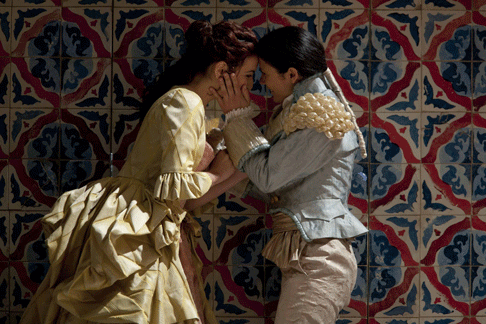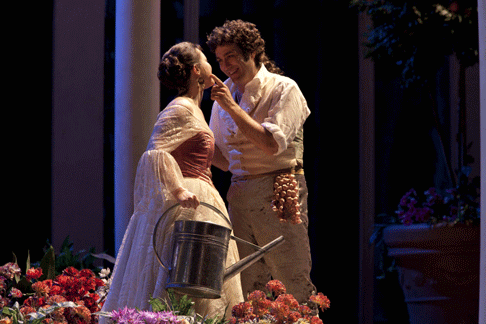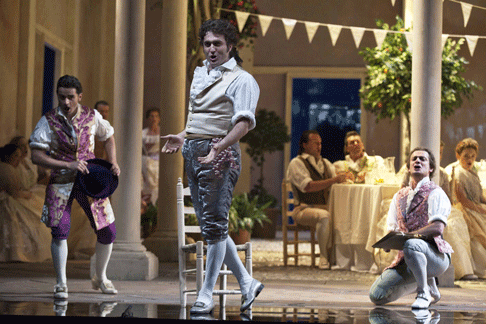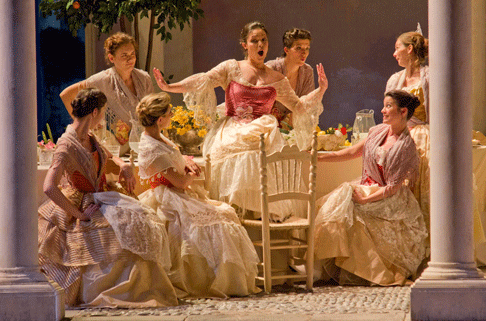His nine titles sparsely revived so far
since the 1910s, starting from Il Giuramento through La
Vestale and Il Bravo to Caritea regina di Spagna and
Elena da Feltre (to quote only the most successful), seemed to confirm
that old judgment. Mercadante, a learned composer and a pious man who
atypically devoted a large share of his output to both church and purely
instrumental music, was hitherto construed as unfit for the comic.
Thus I due Figaro, whose original manuscript was recently unearthed
in Madrid’s Biblioteca Histórica Municipal by the young Italian researcher
Paolo Cascio, may appear a big surprise. It certainly was to Riccardo Muti who,
on recalling his first reading of a few samples from the critical edition
(later published by the same discoverer in collaboration with Víctor Sánchez
Sánchez), declared: “I was unaware of [Mercadante’s] knack for comedy.
Those pages came to me like a bolt from the blue.” To the Maestro’s credit
goes the decision of presenting such an unknown score both at the Whitsun
Festival in Salzburg and at his proprietary Ravenna Festival, if only for a
short run of two nights each time. Next comes Madrid’s Teatro Real in 2012,
but one may comfortably guess that many an opera house is already queuing for
joining in. Our TV-oriented culture is so much dependent on prequels and
sequels that success cannot lack.
The same was true also for early 19th century Madrid, not a provincial
backwater at all, rather a flourishing colony of Italian opera outside Italy as
much as it was during Farinelli’s tenure of the court theatres a century
before. Mercadante, appointed as resident composer-cum-conductor at the Teatro
del Príncipe, wrote there his I due Figaro, on a libretto by the
starring poet Felice Romani previously set to music in 1820 by Rossini’s
pupil Michele Carafa. The completed score was signed by Mercadante on October
26, 1826, but under the reactionary rule of Fernando VII the local censorship
was unhappy with the representation of empowered women and gullible husbands,
so the premiere was cancelled. It was only in 1833 that the opera crept its way
on the Spanish stage, although the exact whereabouts are unknown; then an
equally obscure revival took place in 1836, then nothing more.
To put it in a nutshell, the ‘scandalous’ story is about how, twelve
years after Figaro’s marriage with Susanna, life goes on in Almaviva’s
castle. In competition with Beaumarchais’ own nondescript sequel as La
mère coupable (1791), the actor Honoré-Antoine Richaud Martelly produced
in 1795 his Les deux Figaros, where Cherubino, now a colonel in the
Spanish army, is in love with Inez, the daughter of Count and Countess
Almaviva. Figaro number one entices the Count into having the girl married with
Torribio, a servant disguised as a nobleman, in order that both accomplices can
share her dowry fifty-fifty. Yet Susanna, Inez and the Countess finally defeat
their home tyrants as Cherubino, entering the Count’s service as a
self-styled Figaro number two, outwits the original with a salvo of tricks and
succeeds in exposing his schemes. Inez and Cherubino are allowed to marry,
while Figaro barely escapes being fired.
 Rosa Feola as Inez and Annalisa Stroppa as Cherubino [Photo by Silvia Lelli]
Rosa Feola as Inez and Annalisa Stroppa as Cherubino [Photo by Silvia Lelli]
Despite a necessary suspension of disbelief, the French comedy (and the
Italian libretto derived from it) is less a farce than a semi-serious drama, a
study in characters where psychological depth is not missing. Both veteran
couples, the masters and the servants, seem worn-out and complain about the
ephemeral nature of romance; moreover, the Countess is aware that Almaviva is
still attracted by Susanna, so that the general reconciliation in the finale
seems highly perfunctory. Is there such a thing as a happy marriage in the long
run, and will the brand-new couple escape what seems a general fate? A further
sequel was perhaps in sight, but none has written it so far.
Mercadante’s music adheres to the subject matter with admirable
cleverness, if not with a particularly idiomatic style. One tastes now and then
Mozart’s subtle characterization of both vocal and instrumental color, but
more often the model is provided by Rossini, up to quotations or paraphrases of
individual themes. Intoxicating accelerandos and crescendos in the large-scale
multisectional ensembles were rather commonplace at that time, as were extended
cantabile arches or abrupt dramatic twists in the harmony. Summoning
such names as (again) Rossini, or Bellini, or Donizetti would seem unnecessary,
were it not to avow that in most instances Mercadante can well stand up to the
paragon.
 Eleonora Buratto as Susanna and Mario Cassi as Figaro [Photo by Silvia Lelli]
Eleonora Buratto as Susanna and Mario Cassi as Figaro [Photo by Silvia Lelli]
Everything as expected, except for a decided vein of local color: not only
the fandango once so dear to Mozart, but a regular orgy of rhythms and forms
from Andalusia (after all, the action takes place in the castle of Aguas
Frescas near Seville). Bolero, cachucha, polo and
tirana keep infiltrating over and over the principals’ cavatinas and
even the overture, while the large Italian-style arias, studded with virtuosic
coloratura, demand vocalist with considerable natural gifts, technical skills,
and style awareness.
Eleonora Buratto, whom I recently heard in Modena as a model Cleopatra in
Handel’s Giulio Cesare, towered here in the role of Susanna, with
all the remaining ladies accompanying her in triumphal procession: witty Asude
Karayavuz as the Countess, mellow Rosa Feola as Inez, and Annalisa Stroppa as a
Cherubino already eligible for the toughest Colbran roles. Among the gentlemen,
duels of both physical and vocal energy between Mario Cassi as Figaro number
one and Omar Montanari as Plagio, the playwright in distress much in the mould
of Prosdocimo in Rossini’s (and Romani’s) Il Turco in Italia.
Passion and melancholy in store from the high tenor Antonio Poli as Almaviva;
Anicio Zorzi Giustiniani, a promising Baroque specialist, seemed underutilized
in the cameo role of Torribio. Incredible but true: within such a brilliant
company, hand-picked by Riccardo Muti, none exceeds the age of thirty; the same
is more or less true for the youth orchestra “Luigi Cherubini”, another
brainchild of Muti’s.
 Anicio Zorzi Giustiniani as Torribio, Mario
Cassi as Figaro and Omar Montanari as Plagio [Photo by Silvia Lelli]
Anicio Zorzi Giustiniani as Torribio, Mario
Cassi as Figaro and Omar Montanari as Plagio [Photo by Silvia Lelli]
Emilio Sagi’s stage direction kept the action revolving within and around
a patio decorated with eight columns in white plaster and lots of flowers.
Everything, including costumes, as Spanish, rural and historically informed as
one could wish. To be sure, Ravenna Festival is not the proper place for
Eurotrash. The audience, having to face a complex plot without any subtitles to
help them, seemed to appreciate, but the loudest applause was as usual for the
local darling Muti, the man who is bringing Ravenna back on the international
map of opera.
Carlo Vitali
 Eleonora Buratto as Susanna and country lasses [Photo by Maurizio Montanari]
Eleonora Buratto as Susanna and country lasses [Photo by Maurizio Montanari]
![Eleonora Buratto as Susanna [Photo by Maurizio Montanari]](http://www.operatoday.com/I_Due_05.gif)



